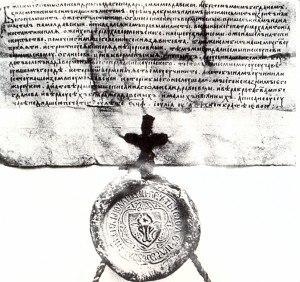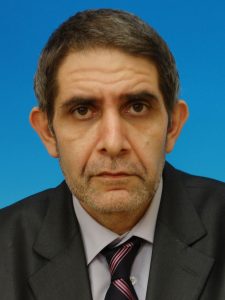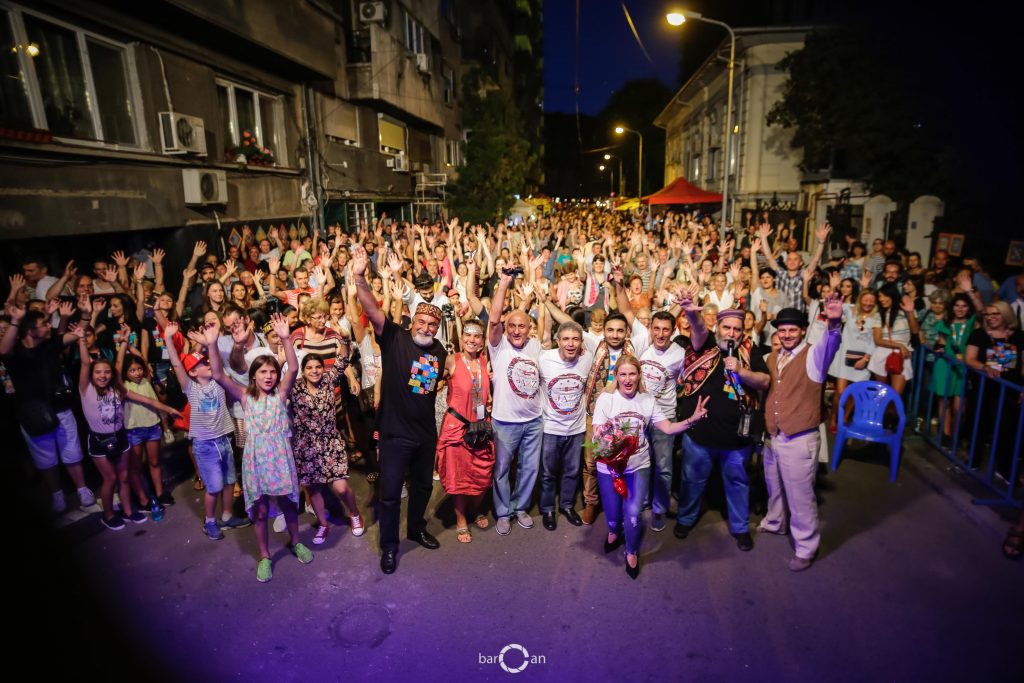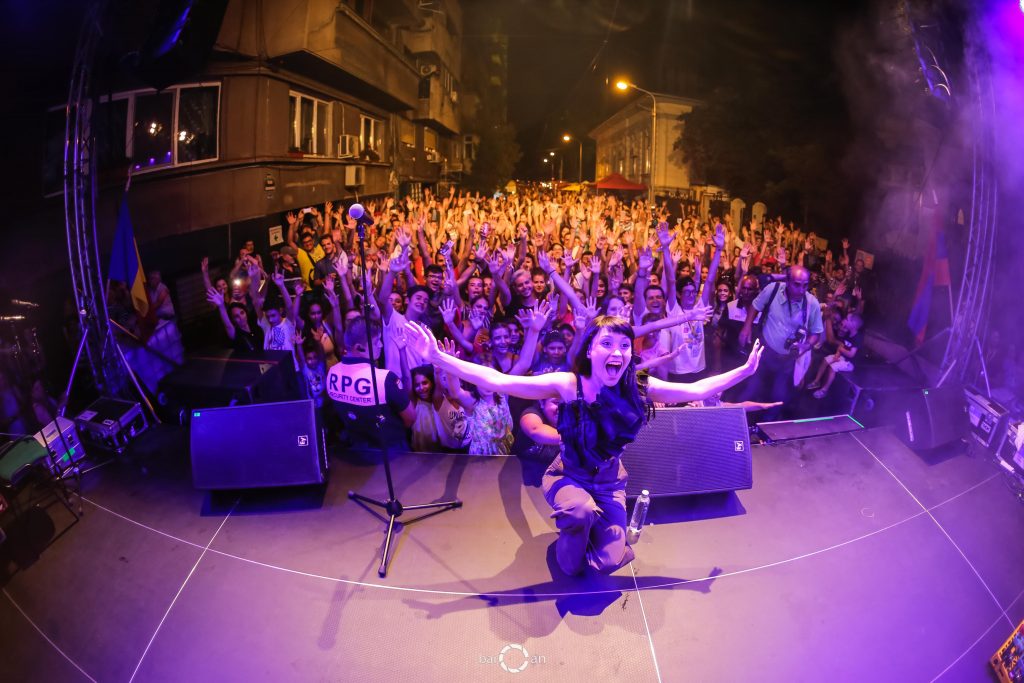The earliest proof of the presence of Armenians on Romanian land is an inscription on a grave, dated 967 AD, in the city of Cetatea Albă – Moldavia (Republic of Moldova today). Hungarian chronicles by Simon de Kezai and Thuroczi, say that during the reign of duke Géza and of King Ștefan (997-1038), in the kingdom, settled along with Polish, Greeks, Spanish and others are a great number of Armenians who received privileges and noble degrees. By 1060, a small Armenian colony had been established in Moldavia. It comprised of immigrants that had fled the city of Ani, the capital city of Armenia at the time, were a big earthquake struck happened.
The Armenians who arrived in Moldavia were merchants and craftsmen; most of them wealthy, who, thanks to the privileges they obtained and the development of commerce in which they had a great impact on, brought a great deal of prosperity in Moldavia. Nicolae Iorga, a great Romanian scholar once said: “Principality of Moldavia was created through commerce, and those who did commerce became contributors in the creation of the national state in Moldavia. Therefore Armenians are, in some way, the parents of Moldavia”.

The most important document, which can be considered as a ‘birth certificate’ for the Armenians settled on Romanian land, is the charter (hrisov in Romanian) dated 30th of July 1401,through which the Moldavian ruler Alexandru cel Bun (1400 – 1431, Alexander the Good) allows Armenians to have their own Bishop, his seat being in Suceava city, the capital fortress of Moldavia. He later issues another charter, dated 8th October 1407, through which he calls for Armenian merchants from Poland to contribute to the prosperity of the Moldavian cities in exchange for no custom duties and other local fees. About 700 Armenians settle in Suceava city and another 3000 in seven Moldavian cities: Suceava, Botoşani, Iaşi, Galaţi, Vaslui, Dorohoi and Hotin. During the reign of Ștefan cel Mare (1457-1504, Ștefan the Great), an important figure in the Romanian history, around 10,000 Armenians settle in Moldavia, therefore the total number of Armenians on Moldavian land being around 20,000 people. ‘The Armenian Carts’, starting from Moldavian cities, carried cattle, cereals and a variety of cheeses to Europe and the Orient, bringing in return carpets, embroideries, silk and spices. We can find a good defining line in regard to Armenians in the writings of the Romanian scholar Nicolae Iorga: “Generally, during those times there was no Moldavian fair, therefore, commerce, without the Armenians.”
In Transylvania, a document dated 1281 by Ladislau IV mentions Terra Armenorum and Monasterium Armenorum which belonged to Armenians. As for the existence of Armenians in Transylvania, the most notable event was the establishment of Armenopolis city (‘Gherla’ today) in 1700. The city was built near the Gherla village. The Armenians had been living in the area since 1672 and having king Leopold I‘s (1657 – 1705) approval, they built the city (Armenopolis). The approval came at a cost of 25000 florins for the land alone. The design project of Armenopolis city was carried out by architect Alexanian. Around 3000 Armenians settled in this city which became an important manufacturing center in Transylvania.

The second city in Transylvania, where Armenians settled, is Elisabetopolis (Dumbrăveni today). An Armenian colony existed here since 1658. In 1799, through an imperial ordinance, Elisabetopolis and Armenopolis became ‘free royal cities’. The Armenians living in this region, which at the time was ruled by the Habsburg Empire, became Catholic, under the Episcopate of Oxendius Vărzărescu. They received privileges and the right to have an autonomous administration. Also in Transylvania, Armenians lived in the following cities: Frumoasa, Sibiu, Oradea, Bistrița, Târgu Secuiesc, Sfântu Gheorghe.
It is remarkable that in those cities which had a major Armenian population, the locals would choose the mayor and the council of elders, but Armenians had their own court where the laws of judging were the first Armenian civil code by Mkhitar Gosh (13th century). Emperor Franz Joseph (1848 – 1916) was once quoted as saying “Armenians are very important for the commerce”.

In Wallachia (Țara Românească or Muntenia in Romanian), Armenians arrived later, around 14th-15th centuries. Their presence was recorded in the cities: București, Târgoviște, Pitești, Craiova, Giurgiu and later in Dobrogea. A charter by ruler Mihai Racoviță, dated 15th February 1742, allowed the Armenians in Bucharest to build their own church on Săpunarilor Street. In 1820, through the ruler Alexandru Șuțu-Vodă’s Carte de reorganizare a breslei (Book of Reorganizing the Guild) Armenians received the permission to choose four trustees and a Guild leader to oversee the goods orders and settle any disputes between Armenian merchants. This eventually led to the creation of specific civil institutions to deal with Armenian affairs and manage relations with the Romanian administration.
In the sites they settled, the Armenians built their own churches. Some of them still exist today; among which are: in Moldavia: Hagigadar Monastery (Fulfilling of the wishes, 1512) and Zamca Monastery (1606), Saint Simeon Church (1513) and Holy Cross Church (1521) in Suceava; Saint Mary Church (1350), Holy Trinity Church (1795) and Annunciation Church (1884) in Botoșani, Saint Mary Church (1395) in Iași, Saint Mary Church (1609) in Roman, Saint Mary Church (1825) in Târgu Ocna, Saint George Church (1733) and Saint Mary Church (1780) in Focșani, Saint Mary Church (1858) in Galați; in Wallachia: Saint Mary Church (1872) in Brăila, Saint Gregory the Illuminator Church (1885) in Tulcea, Saint Mari Church (1880) in Constanța, Saint John The Baptist Church (1852) in Pitești. The Armenian Cathedral Saints Archangels Michael and Gabriel in Bucharest opened in 1915. It was built on the same site where another Armenian church existed in the 17th century. Its architectural style bears resemblance to the iconic Etchmiadzin Cathedral in Armenia.
In Transylvania, all the religious Armenian sites are Catholic: The Holy Annunciation Church known as Solomon Church (1724) and Holy Trinity Cathedral (1776) in Gherla, Saint Elisabeth Cathedral (1850) in Dumbrăveni, Saint Mary Church (1733) in Gheorgheni and Holy Trinity Church (1785) in Frumoasa. Throughout the centuries, there have been Armenian churches which were either destroyed or given to the Romanians, other ethnicities or religious cults due to a decrease number of Armenians living in those areas.

An important element for the survival of Armenians’ identity is its language. The first wave of immigrants spoke the Armenian that was spoken in the Armenian land. This later changed by adoption of words from the Romanian language and other ethnic groups that were living in Romania such as the Polish, Turks and Tatars. This led to the birth of both the Moldavia and Transylvania Armenian dialects. However, these dialects were short lived and the main dialect at the beginning of the 20th century was Western Armenian, predominantly spoken by the immigrants who survived the Genocide by the Ottoman Empire. The Armenian language was kept alive and passed on through schools which were usually built near Armenian churches and monasteries.
The first Armenian ABC book Cheul cetirii literelor mesrobiene (The Key of Reading the Mesrobian Letters) was printed in Iași, at ‘Albina’ printing house, in 1847, under the supervision of Gheorghe Asachi, an important Romanian scholar of Armenian origin. Also, Dogma creștinească după credința Sfintei Biserici armenești (Christian Dogma According to the Faith of the Armenian Holy Church) was printed at this printing house.
In 1911 (Bucharest) began the publishing of ‘Masis’, a collection of children’s literature. In Frumoasa (1938), the scholar Mgrdici Bodurian published, among other titles, an ‘Armenian Encyclopedia’.
The work of the most important Romanian poet Mihai Eminescu was translated into Armenian, mostly by the historian and orientalist H. Dj. Siruni. This includes the well-known masterpiece ‘The Evening Star’ (Luceafărul).
The Armenian press has been very active over the last 100 years. More than 30 journals and newspapers with important roles in the existence of the Armenian community have been published. The first Armenian publication, in Hungarian language called ‘Armenia’ was published in Gherla between 1887 and 1907, under the supervision of the historian Kristoff Szongott. Later, a long list of publications followed, in both Armenian and Romanian, some of them still exist today like ‘Ararat’ magazine – established in 1924 by journalist Vartan Mestugean – and ‘Nor Ghiank’ magazine (since 1950). Today they are published at the Union of Armenians in Romania location.
About the remarkable individuals of the Armenian community from Romania you can find out more by clicking here.
The Union of Armenians from Romania (UAR) was established on 25th January 1919, with the aim of helping the Armenian refugees that fled the Ottoman Empire after the Armenian Genocide in 1915.
Grigore Trancu–Iași was the honorary president of the Union, later succeeded by Armenag Manissalian, who devoted a great deal of his time helping over 10,000 Armenian refugees obtain the Romanian citizenship. UAR played a special role during the interwar period by supporting the opening of the Consulate of the first Armenian Republic in Bucharest in 1920.

It financially supported Armenian schools and churches. It played a great role in bringing Armenian orphans during and after the Genocide (1915-1923) and housing them in an orphanage that UAR built in Strunga, a settlement in Iași County. After the occupation of Romania by the Soviet army, UAR ceased to exist. The only institution officially acknowledged by the Romanian state was the Armenian Church, represented by the Archiepiscopate of The Armenian Church in Romania. During the communist period, the Armenian community continued its activities, having the Armenian Church at its center.
Between 1960 and 2010, Archbishop Dirair Mardichian occupied the highest rank in the Armenian Church of Romania and Bulgaria. Since 2010, Bishop Datev Hagopian is the the Primate of Romanian Diocese of the Armenian Church.
Armenian Community Post-1989
After the 1989 Romanian Revolution, the Armenian community got together and re-established the ‘Union of Armenians from Romania’. On 8th February 1990, through a court decision, the UAR was established as a legal entity with the aim of preserving the cultural and spiritual heritage, and promoting the interests of the Armenian community in Romania. Shortly after its re-birth, more branches of UAR opened across Romania.
UAR has consistently been represented in the Romanian legislative assembly. In the Temporary Council of National Union (2nd February – 20th May 1990) UAR was represented by Varujan Vosganian, Sergiu Selian and Nşan Bogdan Căuş.
Between 1990 and 1996, Varujan Vosganian, elected president of the Union of Armenians from Romania, with a PhD in Economy and a graduate of the Faculty of Mathematics, was elected as UAR deputy in the Romanian Parliament. After 1996, UAR had a double presence in the Romanian governance: while V. Vosganian became senator representative of the Uniunea Forțelor de Dreapta party (Right Wing Forces Union) and the president of the Budget-Finance Committee of the Senate, still holding the presidency of UAR, Varujan Pambuccian, university lecturer at the Faculty of Mathematics of Bucharest, was elected as UAR deputy. In the 2000- 2004 and 2004-2008 legislatures, V Pambuccian was elected president of the Committee of High Technology in the Romanian Chamber, a committee established by him which still functions today. Between 2006 and 2008, V. Vosganian was chosen Minister of Economy and Commerce, during prime-minister Călin Popescu Tăriceanu’s cabinet. Starting April 2007 he took over the Ministry of Finance as well. During 2012-2013, V. Vosganian became for the second time Minister of Economy in prime-minister Victor Ponta’s cabinet.
UAR has always obtained more votes in elections for the national minorities than the electoral threshold. Since 1992, UAR has run the presidency of the National Minorities Group (excluding the Hungarian minority) in the Chamber of Deputies. After the last legislative elections in 2016, V. Pambuccian reconfirmed his mandate of UAR deputy, V. Vosganian won a mandate of deputy as ALDE party representative in Iași County and Lucian Eduard Simion, UAR president of the UAR Tulcea branch, won a mandate of deputy from the PSD party, in Tulcea County.
UAR’s activities and its two representatives in the Romanian Parliament have helped Armenians from Romania earn rights and highlight their presence among the Armenian Diaspora. UAR benefits from annual financial support from the budgetary law. Therefore, the community enjoys publishing of Armenian language books and running its weekend schools which are part of the official national educational network.
Through the Romanian Constitution and Electoral Law, UAR has the right to take part in local and Parliamentary elections. To this day, UAR has won a deputy position at every election. By tradition, the national minorities in Romania group choose as their group representative the UAR deputy. UAR has used its influence and promoted prefects and sub-prefects among its members in counties where the Armenian community has an important presence. The Romanian State provided financial support for renovating Armenian religious sites as well as funding cultural and religious activities. The leader of the Armenian Diocese in Romania and the Armenian priests are paid by the Romanian State for the services they provide to the community. The leader of the Armenian Diocese in Romania has a diplomatic status.
The monthly publication ‘ARARAT’ surfaced again after 1990. It used to exist in the interwar times as well. It is printed in Romanian language. The editors-in-chief, have been Arșag Bogdan Căuș, Bedros Horasangian and currently Mihai Stepan-Cazazian.
‘Nor Ghiank’ (New Life) is also a monthly publication, both in Armenian and Romanian language. Once a weekly magazine, it is had the most longevity in the Armenian Diaspora; enjoying an uninterrupted publication since the 1950s.
The Ararat Publishing House was established in 1994, under the leadership of the writer Ştefan Agopian. He worked along with Mihai Pascu, Emanuel Actarian and the current director Sirun Terzian. To this day, more than 200 books have been printed at the Ararat Publishing house.
When the Armenian Sunday School of Bucharest ‘Misakian-Kesimian’ reopened, the Armenian youth got the opportunity to continue learning the Armenian language and participate in cultural activities. Some of the activities include singing and theatre performances which mostly took place at the end of the school term or on certain religious celebration days. The school initially started as a Sunday school, but later extended to include Saturdays, due to a rise in the number of students. All of these activities – educational and cultural, were successfully conducted by Ulnia Blănaru-Maganian. For each of these events, the choir was accompanied by the pianist Carmen Asfadurian. Over time, the cultural activities began to diversify to enable the children to attend more classes such as: Dance and Stage Movement with Izabela Bostan and Florin Kevorchian, Technical drawing with Paruhi Tepelichian, History with Siran Navrouzian, Computer with Mirela Pambuccian and Armenian Dance with Bela Martikian. When Bela Martikian started the Dance classes, the dance group was called ‘Hrestag’. Eventually, along with its members, the group renamed itself to ‘Vartavar’. When Ulnia Blănaru-Maganian decided to stop her activity, Arpiar Sahaghian took over. Following, for a while, Narine Bogdan-Căuș taught Western Armenian. Today, Arșaluis Paronian teaches Eastern Armenian. For those Romanian speakers willing to learn Western Armenian language, Ulnia Blănaru-Maganian wrote the book ‘Armenian Language’ which can be found at the Publishing House Ararat. For those interested in the Eastern Armenian language, at the same publishing house you can find the book ‘Learning Armenian Without a Teacher’, signed by Arsen Arzumanyan.
The students of the Armenian School in Bucharest have had the chance to participate in different inter-ethnic festivals (Sighișoara, Sibiel, Tulcea, Cluj-Napoca, Bacău) where they presented the Armenian traditions and heritage. Along with the Vartavar dance group from Bucharest which had representations in various locations, including Armenia and Greece, the Armenian community is proud to be represented by dance groups in the country who, as well, have performed at various festivals: Hayakaghak (Gherla), Siamanto (Iasi) and Nairi (Constanta).
With the support of the UAR, the students got the opportunity to visit Armenia through the Ari Tun and The Summer Armenian Language School programs, coordinated by the Ministry of Diaspora in Armenia. They also took part in the Armenian Language Classes in Venice, in voluntary programs through Birthright Armenia / Depi Hayk organization and internships programs through AGBU organization. Some of the Armenian youngsters choose to be students of the highly recommended Armenian School Melkonian in Nicosia.
Since 1993, ‘Union of Armenians in Romania Awards’ (here) has been awarded to Armenians from Romania who brought positive contributions to various sectors of life, thus sustaining the prestige of the Armenian community in Romania. The UAR supports activities of both the Armenian Apostolic and Armenian Catholic Churches.
UAR organizes the popular Armenian Street Festival (here) in 2013-2015 and 2017-2019. The festival sees attendance of around 10,000 people soaking up the atmosphere of the 3 day event. The festival consists of cultural performances, live music, Armenian cuisine, Armenian calligraphy and walks in the Armenian neighborhood. Some of the attendees are the Greeks, Jews and Rroma minorities.
In 2012 and in 2013, The Union of Armenians from Romania, in collaboration with the National Village Museum “Dimitrie Gusti” from Bucharest successfully organized Armenian Cultural Days in Bucharest.
In 2012, the Armenian Cultural Centre opened in Bucharest. It has since played host to numerous important guests from both Romania and Armenia. Among the guests were: Hayk Demoyan the Director of the Armenian Genocide Museum Institute of Yerevan, Historian Claude Mutafian and Armenia’s ex-prime-minister Vazgen Manukyan. Similarly, in the past, cultural evening events by Ararat Magazines were held at the Dudian Library. Some of the discussion topics were: Eminescu and the Armenians (Mihai Eminescu is considered the greatest Romanian poet), Acterian family and the Romanian culture, Anda Călugăreanu (Romanian singer of Armenian origin), activity and work of the great Baritone David Ohanesian and the similarities of Romanian and Armenian folk music. Among the guests were: Actors Ion Caramitru, Dan Puric, Florian Pittiș, Poet Ana Blandiana, Singer-songwriters Tudor Gheorghe and Doru Stănculescu, Scholars Alexandru Paleologu and Barbu Brezianu, Historian Andrei Pippidi and Academician Răzvan Theodorescu.
Some of the cultural manifestations at Dudian Library are the book premieres for the books published at Ararat Publishing House or other publishing houses where books on Armenian subjects were published. To be mentioned that some of these book premieres take place in different Romanian bookstores and universities from Bucharest and other Romanian cities, as well.
An invaluable book worth mentioning albeit not produced at Ararat Publishing House is ‘Armenian Artistic Heritage in Romania and Between Exilic Nostalgia and Cultural Integration’ written by an assistant professor Vlad Bedros from the National University of Arts in Bucharest. A must have photo album, which represents the Armenian community of Romania, is one by Andreea Tănase, ‘Armenians in Romania’ (here). As the popularity of Armenians grew, some students enlisted the support of the Armenian community to write their Master’s thesis and/or PhDs on Armenian related subject and consequently, books were written and published on the matter.
Each year on 24th of April, the Armenian communities in Romania organize events for commemorating the Armenian Genocide which took place in the Ottoman Empire in 1915 to 1923. In the Romanian Parliament, Varujan Vosganian and Varujan Pambuccian always remember to mark this day, doing a permanent lobby for Romania to recognize the Armenian Genocide.
Organised scientific conferences, exhibitions, concerts, summer schools, youth camps and many more activities take place in Armenian communities across Romanian cities.
To learn more about the activities of the Armenian community, check out the online monthly newspaper of the ‘Armenian Union of Romania’, Ararat (www.araratonline.com), in Romanian, and Nor Ghiank (New Life), in Armenian.
Translated by Mariam-Hasmig Danielian, Armen Kanikanian (UK) and Ashley Juskalian (USA).





